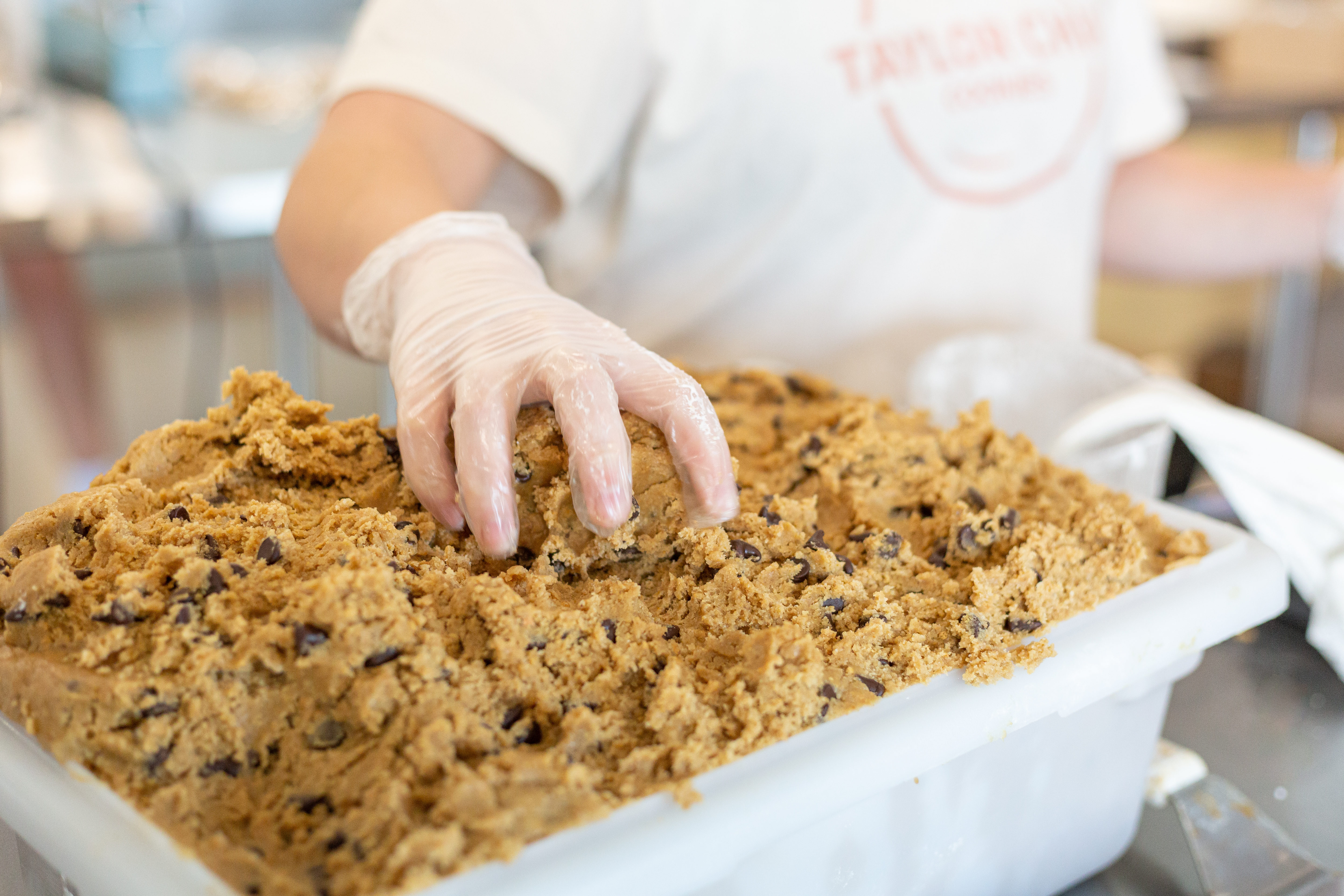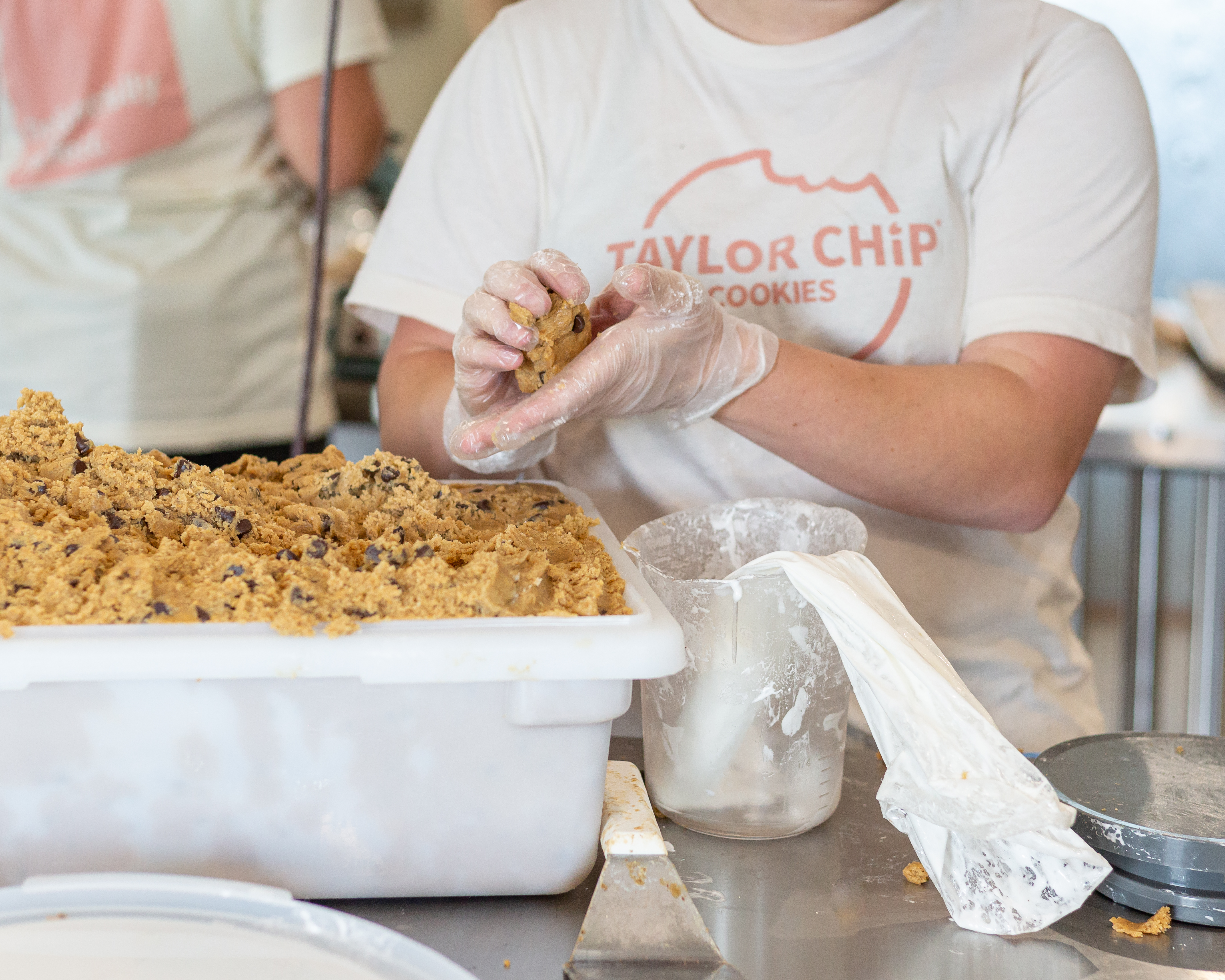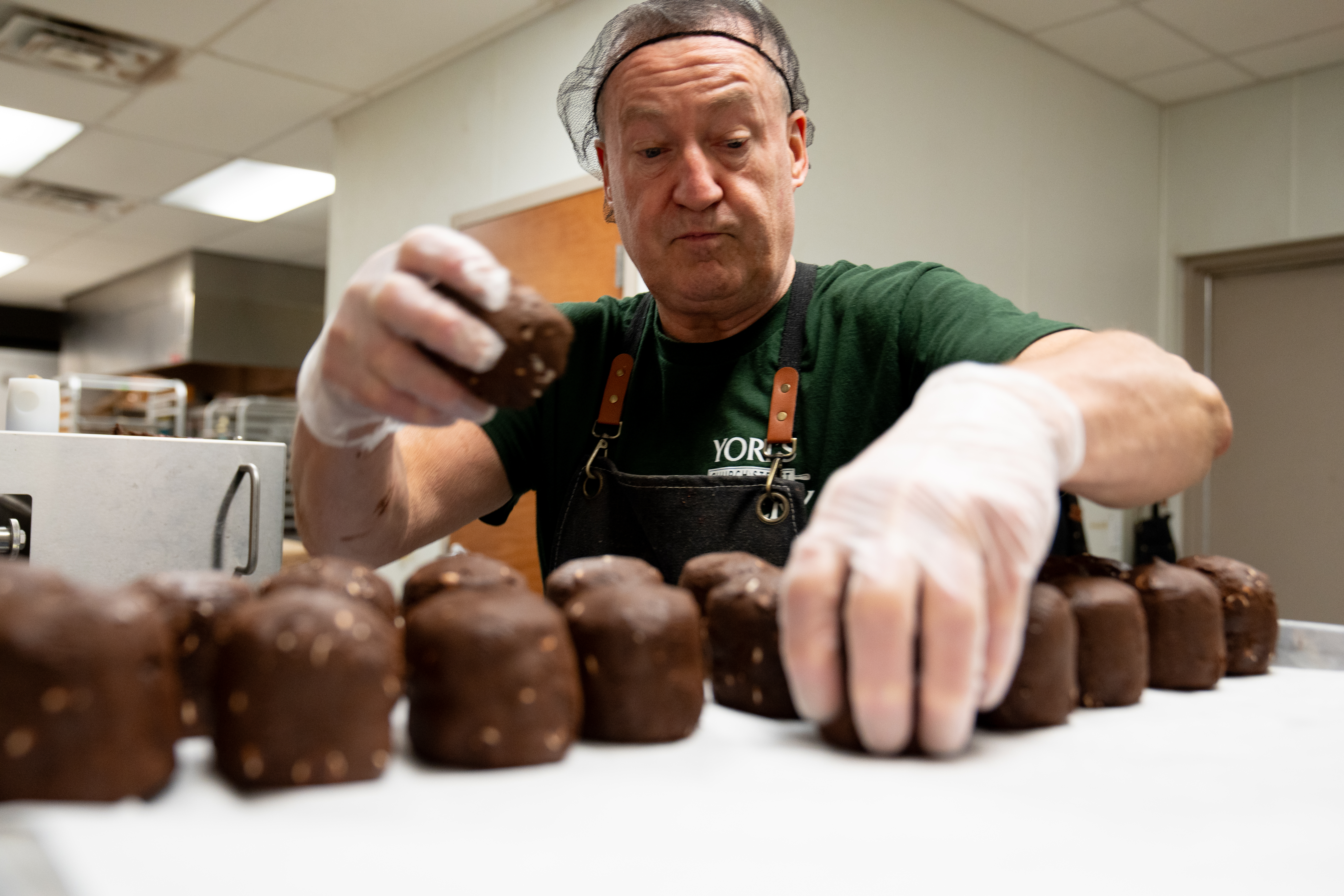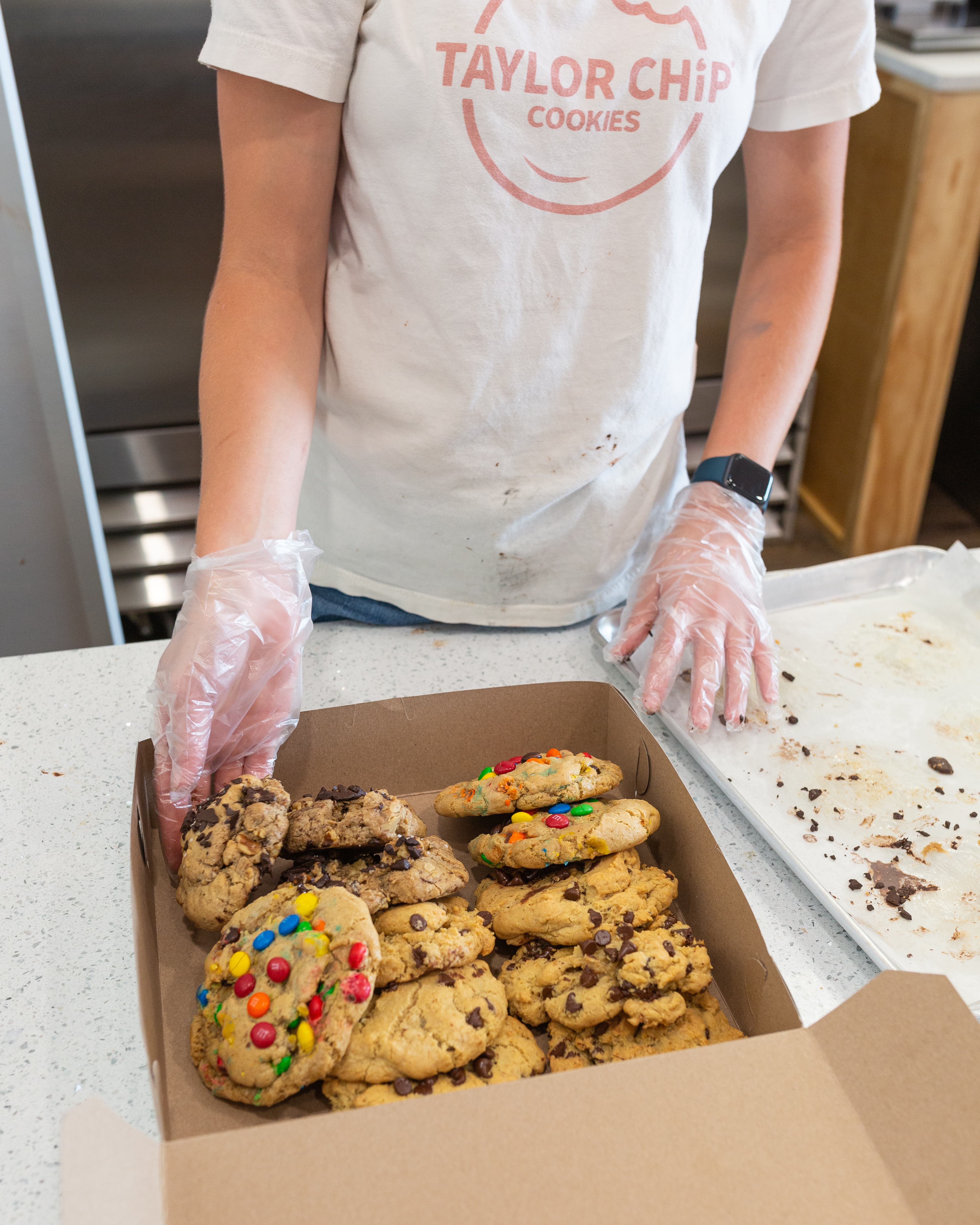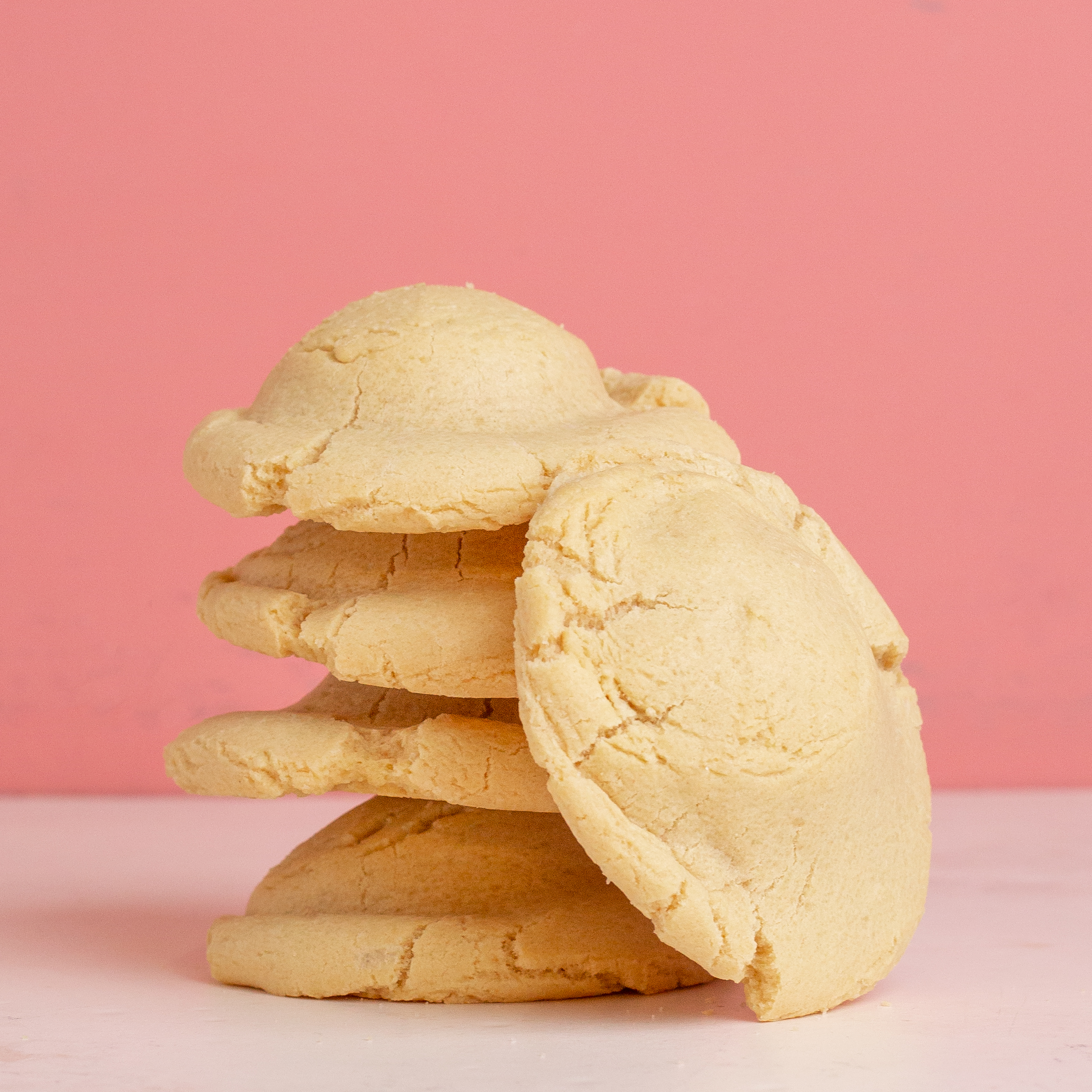Want to bake perfect sugar cookies? Avoid these common mistakes. First, use the right sugar type - granulated or brown. And get butter temperature just right - not too warm or cold. Measure flour accurately to keep that texture on point. Be careful with mixing - avoid overmixing for tender cookies. Don't neglect chilling the dough for that extra flavor. Roll dough evenly, not too thin or thick. Also, go for powdered sugar, not flour, when rolling. Manage oven temp and don't overcrowd the baking sheet. Intrigued? Keep uncovering more secrets for sugar cookie success.
Key Takeaways
- Using the wrong sugar alters taste/texture.
- Improper butter temp affects structure.
- Inaccurate flour measurement impacts texture.
- Mixing errors lead to tough/uneven cookies.
- Chilling dough enhances flavor/texture.
Ingredient Errors
Using the wrong type of sugar, like granulated instead of powdered, can throw off the texture and sweetness of your cookies. Make sure your butter is at the right temperature - too soft or too cold can mess with the cookie's structure. And, always measure your flour accurately to avoid dense, dry cookies.
Using the Wrong Type of Sugar
If you mistakenly use the wrong type of sugar in your sugar cookie recipe, it can greatly impact the texture and taste of the final product. The type of sugar you choose plays an important role in achieving the desired result. For classic sugar cookies with a buttery flavor, using the right sugar is essential. Brown sugar can make your cookies chewier, while granulated sugar gives that classic, crisp texture.
For those looking to create cake-like decorated sugar cookies, opting for powdered sugar can enhance the texture and appearance. Colored sugar can add a fun twist to your cookies, but be mindful of the impact it may have on the flavor profile. If you're aiming for an authentic sugar cookie flavor, sticking to the traditional sugars is recommended. Whether you're baking up classic drop-style vegan sugar cookies or experimenting with new variations, choosing the right sugar will ensure you end up with actual sugar cookies that delight your taste buds.
Improper Butter Temperature
When baking sugar cookies, ensuring the butter is at the necessary temperature is essential for achieving the desired texture and structure in your cookies. Improper butter temperature can lead to cookies that spread too much or don't hold their shape. If your butter is too warm, the cookie dough will be greasy and may spread excessively during baking. On the other hand, if the butter is too cold, it won't cream properly with the sugar, resulting in a dense and crumbly cookie.
To avoid this issue, make sure your butter is at room temperature before creaming it with the sugar. If you're using vegan butters, make sure they are softened but not melted. This step is critical for both traditional and vegan sugar cookies. Proper butter temperature is key not only for the baking process but also for cookie preservation. Storing sugar cookies at the right temperature, freezing them if needed, or following a vegan sugar cookie recipe all depend on starting with the butter at the correct consistency.
Inaccurate Flour Measurement
Improper butter temperature can greatly impact the texture of your sugar cookies, but another common mistake that can affect their outcome is inaccurate flour measurement, especially when it comes to ingredient errors. When it comes to baking accuracy, getting the flour measurement right is essential. One of the most common baking errors is inaccurate flour measurement, which can lead to sugar cookies with a less-than-ideal texture. To guarantee your sugar cookies turn out just right, pay attention to flour precision. The key is to achieve consistency in measuring flour. Scooping directly from the bag can compact the flour, resulting in too much being used. Instead, spoon the flour into a measuring cup and level it off with a knife for accuracy. By taking care with your flour measurement, you can avoid one of the common mistakes that may impact the deliciousness of your sugar cookies.
Mixing Mishaps
Overmixing the dough, undermixing exact ingredients, and forgetting to chill the dough can all lead to less than perfect cookies. So, let's avoid these pitfalls and guarantee our sugar cookies turn out just right!
Overmixing the Dough
Mixing the sugar cookie dough too much can result in a tougher texture and less desirable final product. Here are four tips to avoid overmixing the dough and make sure your cookies turn out perfectly soft:
-
Use a Gentle Hand: When combining the wet and dry ingredients, mix until just combined. Overmixing can lead to gluten development, resulting in tough cookies.
-
Sift Dry Ingredients: Sifting the flour, baking powder, and baking soda together helps distribute them evenly throughout the dough. This guarantees even leavening without the need for excessive mixing.
-
Fold Carefully: When adding in any mix-ins like chocolate chips or nuts, gently fold them in with a rubber spatula. Avoid vigorous stirring that could toughen the dough.
-
Scoop and Shape: Use a medium cookie scoop to portion out the dough onto baking sheets lined with parchment paper. If you're rolling out the dough for cookie shapes, do it on a floured surface with a light touch to prevent overworking the dough.
Undermixing Ingredients
Insufficiently blending the ingredients can lead to uneven distribution and affect the texture of the sugar cookies. When you rush through mixing the dry ingredients like purpose flour, baking powder, baking soda, and salt in the mixing bowl, you might end up with pockets of baking powder or salt in your cookies. That's not going to taste good! Make sure to cream the granulated sugar and butter until it's light and fluffy; this step is essential for the cookies' texture. Adding vanilla extract and almond extract helps enhance the flavor, but if you undermix, you'll miss out on that delicious taste.
Neglecting to Chill the Dough
When preparing sugar cookie dough, make sure to chill it adequately before baking. Here are four essential tips to guarantee your sugar cookies turn out delicious every time:
-
Enhanced Flavor: Chilling the dough allows the ingredients to meld together, enhancing the flavor of your cookies. The result? A batch of irresistible traditional sugar cookies that will have everyone asking for your recipe.
-
Easier Cutting: Chilled dough is firmer and easier to work with when using cookie cutters. This means you'll get clean, precise shapes every time, perfect for creating beautiful and uniform cookies.
-
Prevent Spread: By chilling the dough, you help solidify the fat in the recipe, preventing the cookies from spreading too much while baking. This ensures your cookies maintain their intended shape and don't end up flat and misshapen.
-
Proper Cooling: After baking, transfer your cookies to a wire rack placed on a baking sheet. Allowing them to cool properly ensures they maintain their texture and don't become soggy. So, remember to chill that dough for the best results with your delicious sugar cookies!
Rolling and Cutting Issues
Are you guilty of rolling it too thin or thick, leading to cookies that are either burnt or doughy? Or maybe you've been using flour instead of powdered sugar for rolling, which can affect the cookie's texture and taste. And let's not forget about improper cookie cutter techniques - they can result in misshapen cookies that don't bake evenly.
Rolling Dough Too Thin or Thick
Rolling the dough for sugar cookies to an uneven thickness can lead to baking inconsistencies and uneven shapes. Here are some tips to guarantee your cookies turn out perfectly:
-
Consistent Thickness: Aim for a uniform dough thickness by using spacers or guides when rolling to avoid thin and thick spots.
-
Proper Tools: Invest in a rolling pin with thickness guides or use wooden dowels on each side of the dough for even rolling.
-
Baking Surface: Roll your dough on a clean baking sheet to prevent sticking and make transferring to the oven easier.
-
Adjusting Recipe: If you find your cookies are turning out too thin or too thick, consider adjusting the dough thickness or trying a different recipe that better suits your rolling style.
Using Flour Instead of Powdered Sugar for Rolling
Substitute powdered sugar for flour when rolling sugar cookie dough to guarantee smooth cutting and prevent sticking. Using flour might seem like a quick fix, but it can alter the texture and consistency of your cookies. Powdered sugar, on the other hand, not only helps with rolling but also adds a touch of sweetness to the dough. When you dust your work surface with powdered sugar instead of flour, it blends seamlessly with the dough, enhancing the flavor profile of your cookies. This simple swap can make a big difference in the final outcome of your sugar cookies.
During the baking process, the use of powdered sugar for rolling ensures that your cookies maintain their intended texture and consistency. Flour can make your dough tough and dry, affecting the overall quality of your treats. So, next time you're preparing to roll out your sugar cookie dough, reach for the powdered sugar instead of the flour for a better baking experience.
Improper Cookie Cutter Techniques
To guarantee clean and precise shapes when cutting out sugar cookies, proper cookie cutter techniques are essential. Here are some tips to help you achieve perfect cookie shapes every time:
-
Chill Your Cookie Dough: Make sure your cookie dough is thoroughly chilled before cutting out shapes. This will help maintain the cookie consistency and prevent the dough from sticking to the cutter.
-
Flour Your Cookie Cutter: Lightly dust your cookie cutter with flour before each use to guarantee a clean cut without sticking. This simple step can make a big difference in the final cookie presentation.
-
Avoid Twisting the Cutter: When cutting out shapes, press the cookie cutter straight down into the dough without twisting. Twisting can distort the cookie design and lead to uneven baking.
-
Decorate After Baking: Focus on decorating your cookies after baking rather than before cutting. This way, you can make sure that the decorations stay intact and enhance the overall appearance of your cookies.
Baking Blunders
Let's talk about baking blunders when it comes to sugar cookies. First off, make sure your oven temperature is spot on - too hot or too cold can really mess with your cookies. Next up, be mindful of overbaking or underbaking; finding that sweet spot is key for perfect sugar cookies. And finally, don't overcrowd your baking sheet - give those cookies some room to breathe and spread out for that ideal texture.
Incorrect Oven Temperature
If your sugar cookies are not turning out the way you expected, the wrong temperature could be the culprit. Here are some tips to help you achieve that perfect baking:
-
Preheat Your Oven: Make sure to preheat your oven properly before placing your cookies in. This guarantees even baking and prevents undercooked centers.
-
Invest in an Oven Thermometer: Sometimes, the temperature on the dial doesn't match the actual oven temperature. An oven thermometer can help you adjust accordingly.
-
Rotate Your Baking Trays: If you notice uneven browning, try rotating your baking trays halfway through baking. This assists all your cookies bake uniformly.
-
Check for Hot Spots: Some ovens have hot spots that can lead to uneven baking. To combat this, you can move your trays around or use a baking stone to distribute the heat more evenly.
Overbaking or Underbaking
Guarantee your sugar cookies are perfectly baked by avoiding the common mistakes of overbaking or underbaking. When it comes to baking these sweet treats, timing is everything. Overbaking can leave your cookies dry and lacking that chewy texture you crave. On the flip side, underbaking might seem like a good idea for a soft center, but it can result in cookies that fall apart or have raw dough in the middle. To hit that sweet spot, follow the bake time recommended in your recipe. Keep an eye on your cookies as they bake and aim for that lovely golden brown hue with slightly crispy edges.
Overcrowding the Baking Sheet
To prevent baking blunders, make sure you do not overcrowd the baking sheet when making sugar cookies. Here are some tips to help you avoid this common mistake:
-
Use baking sheets with parchment paper: Line your baking sheets with parchment paper to prevent cookies from sticking and guarantee even baking.
-
Avoid overcrowding the baking sheet: Leave enough space between each cookie to allow for proper air circulation, which helps them bake evenly.
-
Bake in batches: If you have more cookie dough than can fit on one baking sheet, consider baking in batches. This guarantees each cookie has enough room to spread out.
-
Rotate the sheets: If you're baking multiple sheets at once, rotate them halfway through the baking time (around 10-15 minutes) to ensure even baking on all levels.
Decorating Disasters
You've baked your sugar cookies to perfection, but now comes the tricky part - decorating. You start icing your cookies while they're still warm, only to end up with a messy, melted disaster. Or maybe you whip up a batch of runny icing that refuses to stay put, creating a sticky situation. And let's not forget the classic blunder of using too much food coloring, turning your cookies into a vibrant rainbow gone wrong.
Applying Icing to Warm Cookies
Avoid applying icing to warm cookies as it will cause the icing to melt and slide off, resulting in a decorating disaster. Here's why you should wait for your cookies to cool:
- Icing Melts: Warm cookies can't hold the icing properly; it will just turn into a gooey mess.
- Runny Designs: Your carefully piped designs will lose their shape and blend into a sugary puddle.
- Wasted Effort: All the time and effort you put into decorating will be for naught if the icing doesn't stick.
- Uneven Coating: Instead of a smooth and even coating, warm cookies will have a patchy and uneven look.
Using Runny Icing
Wait until your icing has reached the right consistency before attempting to decorate your sugar cookies to avoid a decorating disaster. Runny icing can turn your beautifully baked cookies into a messy situation. To guarantee this, make sure your frosting is thick enough to hold its shape when piped onto the cookies. If your icing is too thin, it will not set properly and can easily run off the edges, ruining your designs.
To achieve a thicker icing, you can add more powdered sugar gradually until you reach the desired consistency. Alternatively, using vegan frosting like cashew frosting can help create a thicker texture perfect for decorating. When you frost cookies with icing that is just right, you'll be able to create stunning designs that hold up and look professional.
For those looking to add color to their icing, opt for natural food coloring to prevent altering the consistency. By using food coloring that won't thin out your frosting, you can ensure your creations remain vibrant and beautiful.
Improper Food Coloring Usage
Using the wrong type of food coloring can quickly lead to decorating disasters when making sugar cookies. Here are some common mistakes to avoid:
-
Guarantee: Adding too much food coloring to your icing can alter the consistency, making it runny or too thin to properly decorate your cookies.
-
Icing Colors: Be cautious when mixing different food coloring shades. Combining too many colors can result in a muddy or unappealing final look.
-
Icing Consistency: Make sure your icing is at the right consistency for decorating. If it's too thick, it will be difficult to pipe intricate designs; if it's too runny, the colors may bleed into each other.
-
Decorating Techniques: Practice different decorating techniques with food coloring to master the art of cookie decorating. From using piping bags for precise lines to experimenting with marbling effects, there are various ways to elevate your cookie designs.
Storage Slip-ups
From the temptation to stash them away before they're fully cooled to the mishap of mixing soft and crisp cookies in the same container, there are a few pitfalls to watch out for. And don't forget about the importance of proper packaging if you decide to freeze some for later – it can make all the difference in keeping your cookies fresh and delicious!
Storing Before Completely Cooled
Before putting your sugar cookies away for storage, make sure they have completely cooled to avoid any moisture buildup. Here are some tips to help you store your sugar cookies effectively:
- Allow Proper Cooling Time: Make certain your cookies cool on baking sheets for the recommended time to prevent excess heat and moisture.
- Avoid Premature Wrapping: Don't rush to wrap warm cookies in plastic wrap as it can trap moisture and lead to sogginess.
- Use Parchment Paper: Place your cookies on parchment paper to cool as it helps in absorbing any excess moisture.
- Store in a Breathable Container: Opt for containers that are not airtight to prevent condensation that can make your cookies lose their crispness.
Mixing Soft and Crisp Cookies
Make sure to separate your soft and crisp cookies during storage to maintain their individual textures and prevent any mixing of moisture levels that can affect their quality. When you mix soft and crisp cookies together, the moisture from the softer ones can transfer to the crispy ones, making them lose their delightful crunch. To keep them at their best, store your brown sugar and almond extract-infused soft cookies in one container and your cane sugar and sea salt-kissed crisp cookies in another. Whether you're prepping for a holiday party or just enjoying a sweet treat at home, keeping them apart is key.
Guarantee your vegan milk and coconut oil creations stay fresh by using airtight containers for both types. Remember, simple ingredients like baking flour and powdered sugar deserve the best treatment to maintain their flavors. By taking this extra step of separating them, you'll ensure that each cookie retains its unique texture and taste until you're ready to enjoy them.
Improper Packaging for Freezing
Improperly packaging sugar cookies for freezing can lead to texture changes and loss of freshness. Here are some tips to avoid these baking mistakes:
- Use Airtight Containers: Seal your sugar cookies in airtight containers before freezing to prevent moisture loss and maintain their softness.
- Avoid Ziplock Bags: Ziplock bags may not provide enough protection against freezer burn, which can affect the taste of your cookies over time.
- Wrap in Plastic Wrap: Before placing the cookies in a container, individually wrap them in plastic wrap to create an extra barrier against freezer burn and moisture.
- Label and Date: Don't forget to label your containers with the date of freezing. This helps you keep track of freshness and ensures you use the oldest cookies first.
Troubleshooting Common Problems
Ever had your sugar cookies spread out too much while baking? Or maybe they came out tough and dry? Don't worry, we're here to help! Let's chat about how to salvage those burnt edges and troubleshoot these common problems together.
Dealing with Spread-out Cookies
If your sugar cookies are spreading out too much while baking, consider adjusting the dough's consistency for better results. Here are some tips to help you deal with spread-out cookies:
-
Chill the Dough: After preparing the dough, let it rest in the refrigerator for 30 minutes to an hour. This helps solidify the fats in the dough, reducing spread during baking.
-
Measure Ingredients Accurately: Use a kitchen scale to measure ingredients precisely. Too much butter or sugar can cause excessive spreading.
-
Use Parchment Paper: Line your baking sheets with parchment paper to prevent the cookies from sticking and spreading too much.
-
Check Baking Time: Bake your cookies in the middle rack of the oven for the recommended time (usually 8-10 minutes). Overbaking can lead to excessive spreading, so keep an eye on them from 11-15 minutes depending on your oven.
Fixing Tough or Dry Cookies
To address tough or dry cookies, consider adjustments in mixing techniques and ingredients for a softer, more enjoyable texture. If your cookies turn out tough or dry, try adding a teaspoon of vanilla extract or almond extract to enhance the flavor and moisture. You can also swap out regular sugar for coconut sugar for a more natural sweetness. Additionally, incorporating a couple of tablespoons of powdered sugar into the dough can help in achieving a softer texture.
Before baking, let the dough rest for a few minutes to allow it to hydrate properly, resulting in a softer cookie. When mixing the dough, be careful not to overwork it; gently combine the ingredients until they form a cohesive ball of dough.
Salvaging Burnt Edges
When salvaging burnt edges on sugar cookies, assess the level of burn carefully to determine the best course of action for remedying the situation. Here are some tips to help rescue your cookies:
-
Trimming: Carefully trim off the burnt edges with a sharp knife to salvage the chewy center of your sugar cookies.
-
Sugar Coating: Roll the burnt edges of your sugar cookies in organic cane sugar to mask the burnt flavor and add a touch of sweetness.
-
Rebaking: If only the edges are burnt, you can try rebaking the cookies for a few minutes at a lower temperature to help even out the texture.
-
Icing or Glaze: Cover the burnt edges with a generous layer of icing or glaze to hide the imperfections and add extra moisture to your cookies.
With these simple tricks, you can still enjoy your classic sugar cookie recipe even if the edges got a little too crispy. Remember, a burnt edge doesn't have to ruin the whole batch!
The Taylors and Taylor Chip
Sara and Dougie, the dynamic duo behind Taylor Chip, found their passion for sweets intertwined with their love story. What started as a fun date night activity soon turned into an obsession as they experimented with different cookie shapes and flavors. As they mixed, rolled, and baked together, their cookies became more than just a treat – they became a symbol of their love and dedication to perfecting the art of baking.
With each batch, Sara and Dougie poured their hearts into creating the perfect cookie. Their journey from baking novices to cookie connoisseurs mirrored their blossoming relationship. Finally, after much trial and error, they felt like they had achieved the ideal balance of flavor and texture, just in time for their wedding. The Taylors and Taylor Chip were not just baking cookies; they were crafting memories and celebrating their love one sweet bite at a time.
The Taylor Chip Vegan Sugar Cookie
Let's explore the Taylor Chip Vegan Sugar Cookie, a delectable treat that masterfully combines gooeyness and crunch with a classic sand tart flavor. When you bite into one, you'll find it hard to believe it's vegan—but it is! What sets this cookie apart is its texture and taste, which make it a standout in the world of vegan treats.
Here are a few key aspects of the Taylor Chip Vegan Sugar Cookie:
- Ingredients: The cookie is made with non-GMO unbleached enriched wheat flour, organic coconut oil, and organic cashews, ensuring every bite is packed with high-quality, cruelty-free goodness.
- Gooey and Crunchy: Achieving the perfect balance, this cookie is gooey on the inside with just the right amount of crunch on the outside, resembling the beloved sand tart.
- Ethical Choices: Every ingredient, from the fair trade organic vanilla extract to the non-GMO aluminum-free baking powder, is selected with care for health and sustainability.
This isn't just a treat for vegans but for anyone looking to indulge responsibly without sacrificing flavor. We're sure it won't disappoint!
Frequently Asked Questions
Can I Substitute Brown Sugar for White Sugar in Sugar Cookies?
Sure, you can totally swap brown sugar for white sugar in your sugar cookies! Brown sugar will give your cookies a richer, more caramel-like flavor. Just keep in mind that the texture might be slightly different, as brown sugar contains more moisture. Experiment a bit to find the perfect balance for your taste buds. Enjoy baking those delicious products with your special twist!
How Do I Prevent Sugar Cookies From Spreading Too Much?
To keep your sugar cookies from spreading too much, try chilling the dough before baking. This helps solidify the fat in the dough, so the cookies hold their shape in the oven. Also, make sure your baking sheet is cool before placing the dough on it. A hot pan can cause the cookies to spread too quickly. By giving your dough a chill and using a cool baking sheet, you'll have perfectly shaped sugar cookies every time!
Why Do My Sugar Cookies Always Turn Out Too Dry?
Feeling like your sugar cookies resemble the Sahara Desert? It could be from overbaking or using too much flour. Overbaking zaps the moisture out faster than you can say "cookie monster," so keep an eye on the timer. Also, too much flour can make your cookies drier than a desert cactus. Try measuring accurately and consider adjusting your recipe slightly to find that perfect balance of moist, chewy goodness.
Can I Freeze Sugar Cookie Dough for Later Use?
Yes, you can totally freeze sugar cookie dough for later baking adventures! It's a fantastic time-saving trick. Just whip up a batch of your favorite dough, shape it into convenient portions, wrap them tightly in plastic wrap or airtight containers, and pop them in the freezer. When that cookie craving hits, you'll have fresh dough ready to go in no time. It's like having a secret stash of cookie magic waiting for you!
What Is the Best Way to Store Decorated Sugar Cookies to Maintain Freshness?
When it comes to storing those beautifully decorated sugar cookies, the key is maintaining their freshness. You want to keep them tasting as scrumptious as when you first whipped them up. One top tip is to store them in an airtight container at room temperature. This helps prevent them from drying out too quickly. If you have a lot to store, layer them with parchment paper to keep them from sticking together. Voilà! Fresh cookies await.
Conclusion
So there you have it, folks! Avoid these common baking mistakes with sugar cookies, and you'll be well on your way to delicious treats every time. Remember to double-check your ingredients, mix with care, roll and cut properly, bake with precision, decorate with flair, and store with caution. With a little cookie troubleshooting and attention to detail, you'll be a sugar cookie pro in no time.





